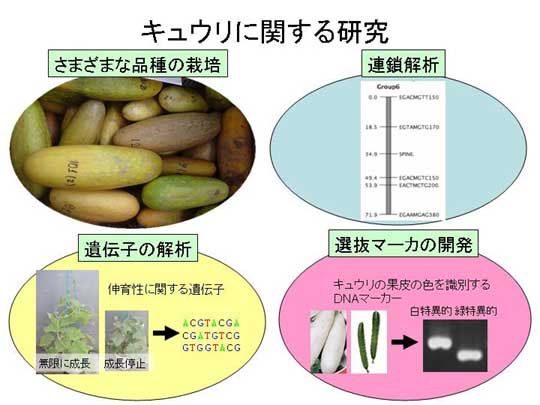




 |
@@Cucumber (Cucumis sativus 2n=2x=14,) is well known as fruity vegetable all over
the world since its simply growth and
wildly
adaptation. Fruit is usually eaten
as either
pickle, slice or cooked in dish. Yet,
the
fruits have many distinct in traits
such
as spine color, fruit color, stripe,
size
and etc. A large variation in length
and
diameter exist. Difference market or
place
prefers difference type of fruit, thus,
each
of these traits is considered important
and
subject to be improved. There is many
breeding
efforts have been carrying on to develop
varieties for their own consumer preference.
However, the information is still far
behind
even comparing to closely related species
emelonf (Cucumis melo).
Numerous of research have been working on
diseases resistance as well as sex expression
related genes since cucumber crop has an
advantage of monoecious and gynoecious. However, other horticulture traits including
growth habit have been often neglected. Cucumber
growth habit or plant type is varying from
compact plant type (the plant produces extremely
short internodes petioles. etc) to very long
plant type known as indeterminate type in
Japan. In between these two plant types,
determinant type whereas the plant growth
apex is terminated by the flowers cluster,
often mapped as phenotype marker known as de on chromosome group 1 same as other phenotype
marker little leaves (ll) and female flower (f) or gynoecius. However, molecular characterization
of de has not yet been understood. Although this crop is ripe for molecular
work since it has rapid life cycle, easily
crossed, and a small genome size approximately
450Mb.
Therefore, our research have been focused on fruit trait
quality and other important horticulture
traits including plant growth habit
in cucumber
by using advance molecular biology
technique.
We are now working on the following topics:
1. FT and TFL1 orthologs genes in cucumber (By SATO Hiroyuki)
2. Contraction of genetic linkage map and
QTLs analysis of fruit quality related
traits
(By HEANG Dany)
3. Study of cytogenetics of cucumber crop
by using FISH method (By KUROZUMI Kenji)
 |